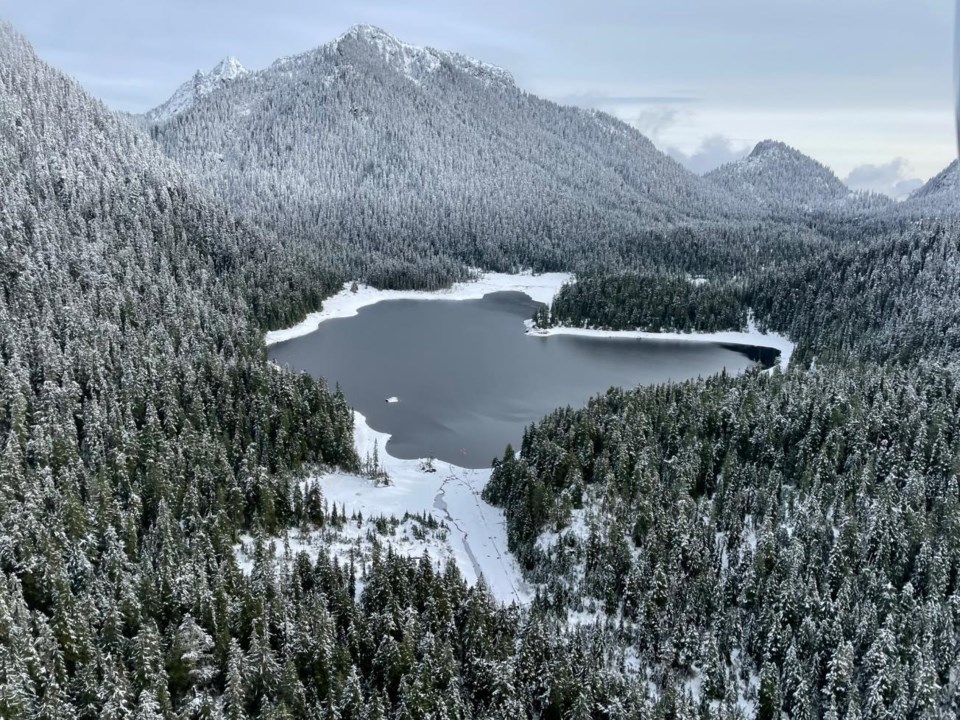Even as the rains fall, the Sunshine Coast remains under a state of emergency, and when that might lift isn’t clear.
Snow and freezing temperatures in the Chapman Creek watershed have meant precipitation isn’t running off to recharge the reservoir lakes of Chapman and Edwards as much as had been hoped, and less water is getting absorbed into the watershed.
And, in non-freezing parts of the watershed, the soil is so dry that water is running off rather than getting absorbed into the soil.
Rather than big dumps of 50 mm of rain that just get flushed through the system, the watershed requires smaller amounts – 10 mm, 20 mm – of rain over days or weeks to recharge, according to Sunshine Coast Regional District (SCRD) general manager of infrastructure services Remko Rosenboom. He gave an update to the SCRD board Oct. 27. “The sponge is still extremely dry.”
Extensions of the state of local emergency, set to expire Oct. 31, are being considered. “It’s still due to the imminent risk that we might lose our water supply,” Rosenboom said.
Siphons shut off
Freezing temperatures have also meant the SCRD has shut off the siphons at Edwards Lake.
Plans to reposition the siphons were cancelled earlier this week because it was unsafe working with snow on the ground, according to Rosenboom, and as of Oct. 28 they were shut down to preserve lake storage and prevent the siphons from freezing. Until Oct. 27, there were three siphons operating at the lake.
A single siphon remains at Chapman. There was not enough water to have more siphons running without running dry, Rosenboom told the board – but it is still running in these freezing conditions.
As of Oct. 13, those two lakes had been providing 66 per cent of the Chapman water system’s total volume.
Water is rising
The good news is water levels are no longer decreasing at the lakes and with the heavy rain overnight Thursday, water levels in Chapman Lake increased by one metre – about 20 per cent of the water needed to fill the lake, an emergency operations centre (EOC) update released Oct. 28 said.
The other good news is that community water demand dropped “the moment the state of local emergency was declared,” said Rosenboom. Use has been hovering between 8 and 8.5 million litres of use a day over the past week. “Which is amazing to see,” said Rosenboom. “But also a good indicator that the community’s fully aware of the situation we're in.”
Church Road coming online
Water supply options are being considered and reconsidered on a daily basis – sometimes hourly, Rosenboom told the board.
The SCRD is going ahead with building a pump to draw a “limited volume of water” through the new Church Road Well Field, according to EOC update. The water is to add about 15 per cent of supply to the water system starting in early November.
Water from the Town of Gibsons (up to one million litres a day) is halted on days when there’s enough Chapman Creek flow, and will run again when it’s needed, said Rosenboom.
Trout Lake is ready to go if needed and Gray Creek has been shut down because of high turbidity levels, according to Rosenboom. But, the SCRD has received Vancouver Coastal Health permission to bring Gray Creek online with a boil water advisory for those supplied by that source, if needed.
What if the lakes freeze early?
There’s the potential that both lakes will not fill before winter starts, which has never happened, according to the EOC update. Usually, the lakes are overflowing this time of year.
It’s not unusual for the lakes to freeze in winter and for there to be a period when the lakes aren’t supplying the water system. Instead, the system’s water comes from precipitation runoff and groundwater infiltration flowing into Chapman Creek. So, if the lakes don’t fill in coming days and weeks, the system will be relying on that runoff and groundwater sooner than usual.
But, again, the freezing temperatures are slowing that watershed recharge. Therefore, the watershed needs continuous rain, in above-freezing conditions, which “would be sufficient to support water supply to the community until next year spring,” said the update.
What’s to come?
A few times during his board report, Rosenboom raised that this is the first state of local emergency because of drought in Canada.
“That is something that I'm not proud of but it's definitely making an impact. And so people are aware of it, and they're looking over our shoulders.”
Rosenboom noted the difficulty of assessing the water situation into the future. “We are in unprecedented territory,” he said. “We do what we can to make predictions, but it's really extremely difficult because we've never been here before.”
In summary?
“Please continue to conserve water. Yes, it's raining outside,” said Rosenboom. “But I think this presentation made it clear. We're definitely not out of the woods yet.”
Rosenboom also reminds residents to clean their culverts and stay informed.
Watch the whole update
Rosenboom covered a lot of ground in his update, from explaining how the watershed works, to the status of leaks, to discussion of environmental flow needs. Watch the update starting at 12:35 in the video below.




